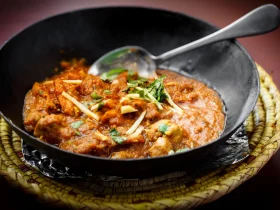Are you ready to embark on a culinary adventure that will tantalize your taste buds? Look no further than this exquisite Fish Biryani recipe! Whether you’re a seasoned cook or a newbie in the kitchen, this step-by-step guide will help you create a mouthwatering masterpiece that’s sure to impress your family and friends. Get ready to dive into the world of flavors and aromas as we explore the secrets behind crafting the perfect Fish Biryani.
[ez-toc]
History
Fish Biryani, a culinary masterpiece that tantalizes our taste buds with its exquisite blend of flavors, holds a rich history that spans centuries. This delectable dish, a harmonious marriage of fish, fragrant rice, and aromatic spices, has its roots in the ancient culinary traditions of the Indian subcontinent.
Origins of Biryani
The origins of biryani can be traced back to the royal kitchens of medieval India. Biryani, with its perfect blend of flavors and luxurious ingredients, was often served to kings and nobles as a symbol of opulence and indulgence. The dish was not only a culinary delight but also a testament to the mastery of spices and cooking techniques.
Evolution and Regional Variations
As biryani gained popularity, it spread across the diverse regions of India, leading to the emergence of various regional variations. The Mughal influence played a significant role in shaping biryani into the dish we know today. The Mughals, known for their love of fine food, brought with them the art of slow-cooking and the use of fragrant spices.
In coastal regions, the abundance of seafood gave birth to Fish Biryani – a variant that showcased the culinary prowess of combining fish with the biryani tradition. The coastal regions of India, particularly the Malabar Coast, Kerala, and parts of South India, embraced the use of fish in their biryani, creating a fusion of flavors that celebrated the bounty of the sea.
Symbolism and Celebrations
Biryani, including Fish Biryani, became synonymous with celebrations, festivities, and communal gatherings. From weddings to special occasions, biryani was often the centerpiece of lavish feasts, bringing people together over a shared love for aromatic rice, succulent meats, and intricate spices. Fish Biryani, in particular, found its place in coastal celebrations, where the catch of the day was transformed into a dish that symbolized unity and joy.
Crafting the Perfect Fish Biryani
The art of making Fish Biryani involves a meticulous process that has been refined over generations. From selecting the freshest catch to marinating the fish in a medley of spices, every step is a testament to the culinary heritage that has been passed down through families.
The introduction of basmati rice, known for its fragrance and long grains, elevated the biryani experience. Layers of marinated fish and aromatic rice are slow-cooked together in a process known as “Dum” cooking, where the flavors meld and infuse, creating a dish that’s more than the sum of its parts.
A Culinary Legacy
Today, Fish Biryani stands as a testament to the rich culinary legacy of the Indian subcontinent. It’s a dish that embodies tradition, celebration, and the joy of sharing a meal with loved ones. As culinary techniques evolve and tastes diversify, Fish Biryani continues to hold its own, bridging the gap between the past and the present, while delighting our taste buds with every aromatic bite.
So, the next time you savor a plate of Fish Biryani, remember that you’re not just enjoying a meal; you’re partaking in a history that’s as rich and flavorful as the dish itself.
Time
| Step | Time Required |
|---|---|
| Prepping the Fish | 20 minutes |
| Creating the Flavorful Marinade | 15 minutes |
| Sizzling Onions and Spices | 10 minutes |
| Adding Tomatoes – The Tangy Twist | 5 minutes |
| The Fragrant Basmati Bed | 20 minutes |
| Alternating Fish and Rice Layers | 15 minutes |
| Achieving the Dum Effect | 25 minutes |
| Sealing the Goodness | 10 minutes |
| Infusing Saffron for Elegance | 5 minutes |
| Fresh Herbs – The Green Finale | 5 minutes |
| Unveiling the Richness | 5 minutes |
| Pairing and Complementing | 5 minutes |
Note: The times mentioned are approximate and may vary based on individual cooking skills and kitchen equipment.
Ingredients
| Ingredients | Quantity |
|---|---|
| Fresh Fish Fillets | 250 grams |
| Basmati Rice | 1 cup |
| Onions | 2 medium-sized |
| Tomatoes | 1 medium-sized |
| Ginger-Garlic Paste | 1 tablespoon |
| Green Chilies | 2 |
| Yogurt | 1/4 cup |
| Fresh Mint Leaves | Handful |
| Fresh Coriander Leaves | Handful |
| Saffron Strands | A pinch |
| Milk | 2 tablespoons |
| Ghee | 2 tablespoons |
| Cooking Oil | 2 tablespoons |
| Whole Spices (Cinnamon, Cardamom, Cloves) | A few of each |
| Ground Spices (Cumin, Coriander, Red Chili Powder) | As needed |
| Salt | To taste |
| Lemon | 1 |
| Water | As needed |
Please note that the quantities mentioned are approximate and can be adjusted based on personal preferences.
Directions
Prepping the Fish
- Clean and Marinate: Start by cleaning the fish fillets thoroughly and pat them dry with a paper towel. Marinate the fish with a mixture of yogurt, ginger-garlic paste, ground spices (cumin, coriander, red chili powder), and a squeeze of lemon juice. Allow the fish to marinate for at least 20 minutes.
Creating the Flavorful Marinade
- Sautéing Aromatics: Heat cooking oil in a heavy-bottomed pan. Add sliced onions, green chilies, and whole spices (cinnamon, cardamom, cloves) to the pan. Sauté until the onions turn golden brown and aromatic.
- Adding Tomatoes: Add finely chopped tomatoes to the pan and cook until they soften and the oil starts to separate. This will create the base of your biryani.
Sizzling Onions and Spices
- Layering the Rice: Rinse and soak the basmati rice for 30 minutes. In a separate pot, bring water to a boil and add the soaked rice. Parboil the rice until it’s 70% cooked. Drain the rice and set it aside.
- Creating Layers: In the same pot, layer half of the parboiled rice. Top it with half of the cooked fish and the sautéed onion and spice mixture. Repeat the layers with the remaining rice and fish.
Adding Tomatoes – The Tangy Twist
- Saffron Infusion: Dissolve a pinch of saffron strands in warm milk. Drizzle the saffron-infused milk over the top layer of rice, creating a beautiful color contrast.
Dum Cooking Demystified
- Sealing the Pot: Seal the pot with a tight-fitting lid. You can use dough to create a seal, ensuring that no steam escapes during the cooking process.
- Dum Cooking: Place the sealed pot on a low flame and cook for about 20-25 minutes. This slow cooking process allows the flavors to meld and infuse, creating a rich and aromatic Fish Biryani.
Garnishes and Aromas
- Unveiling the Aromas: Once the cooking time is up, carefully remove the pot from the heat. Gently open the lid and let the aroma of the perfectly cooked Fish Biryani waft through the air.
- Fresh Herbs: Garnish the biryani with a generous handful of chopped fresh mint leaves and coriander leaves. This burst of green not only adds freshness but also enhances the visual appeal.
Serve and Savor
- Final Touch: Give the biryani a gentle mix, ensuring that the layers are beautifully incorporated. Serve the Fish Biryani hot, accompanied by raita, pickle, and slices of lemon.
- Pairing Perfection: Whether enjoyed with a loved one or shared with friends, this Fish Biryani pairs wonderfully with a simple cucumber raita and a refreshing drink of your choice.
Equipment Required
Nutrition Information
| Nutrition Information | Per Serving (2-person) |
|---|---|
| Serving Size | 1 plate |
| Calories | 450 kcal |
| Total Fat | 12g |
| Saturated Fat | 3g |
| Cholesterol | 60mg |
| Sodium | 700mg |
| Total Carbohydrates | 65g |
| Dietary Fiber | 2g |
| Sugars | 2g |
| Protein | 20g |
Please note that these values are approximate and can vary based on the specific ingredients and portion sizes used. Always refer to specific product labels or consult a nutrition professional for accurate nutritional information.
Tips
- Fish Selection: Opt for boneless fish fillets to make eating a breeze. Ensure the fish is fresh and devoid of any overpowering smell.
- Parboiling Rice: When parboiling the rice, aim for the rice to be 70% cooked. This ensures that it remains fluffy and perfectly cooked during the dum process.
- Layering Techniques: Alternate layers of rice and fish mixture for an even distribution of flavors. Be gentle while layering to prevent the rice from breaking.
- Dum Sealing: Use a tight-fitting lid or dough to seal the pot during the dum cooking process. This prevents steam from escaping and locks in the flavors.
- Low Heat Dum: Cook the biryani on a low flame during the dum process to allow the flavors to infuse slowly and thoroughly.
- Resting Period: After the biryani is cooked, let it rest for a few minutes before serving. This allows the flavors to settle and meld.
Pros & Cons
| Pros | Cons |
|---|---|
| ✔️ Bursting with flavors | ❌ Time-consuming |
| ✔️ Unique and impressive | ❌ Requires multiple steps |
| ✔️ Can be a centerpiece at gatherings | ❌ Requires some cooking skills |
| ✔️ Offers a delightful fusion of fish and spices | ❌ May involve a higher calorie count |
| ✔️ Perfect for special occasions | ❌ Fish selection can be critical |
Conclusion
As we wrap up this flavorful journey through the world of Fish Biryani, we’re left with a symphony of tastes, aromas, and memories waiting to be created. This culinary masterpiece, rich in history and bursting with flavors, invites you to step into the kitchen and embark on an adventure that will leave your taste buds singing with joy.
From the careful marination of the fish to the layering of fragrant rice and spices, every step of the process is a testament to the art of combining ingredients and techniques to create a dish that’s not only delightful to the palate but also a feast for the eyes. The intricate layers, the aromatic spices, and the infusion of saffron – all come together in harmony, offering a taste experience that’s nothing short of extraordinary.
Whether you’re celebrating a special occasion or simply indulging in the pleasure of cooking, Fish Biryani has the power to elevate your culinary repertoire. As you savor each bite, you’ll find yourself transported to a world where tradition meets innovation, and where the simple act of sharing a meal becomes a celebration of flavors.
So, dear reader, the stage is set, and the recipe awaits your touch. Take a leap of faith into the world of Fish Biryani – a world where bold flavors dance on your taste buds and where each bite tells a story of tradition, creativity, and the joy of good food. Let your kitchen be your stage, and let the magic unfold as you create a Fish Biryani that’s truly your own. Don’t hesitate – dive in and savor the delight that awaits you!
Facts
- 🌊 Coastal Infusion
- Did you know that Fish Biryani originates from the coastal regions of India? The abundance of fresh seafood inspired this delectable fusion of fish and fragrant rice. It’s like a delicious ocean breeze on your plate!
- 🎉 Biryani Bonanza
- Fish Biryani isn’t just a dish; it’s a reason to celebrate! In many coastal communities, this savory delight takes center stage during weddings, birthdays, and other festivities. It’s the life of the party, one aromatic spoonful at a time.
- 🍋 Tangy Twist
- The use of tangy tomatoes isn’t just for taste – it’s a culinary strategy! Tomatoes not only add flavor but also help balance the richness of the fish and spices, resulting in a harmonious taste experience.
- 🌶️ Spice Chronicles
- Fish Biryani isn’t just a dish; it’s a symphony of spices! The aromatic whole and ground spices tell a story of ancient culinary traditions, where each spice brings its own unique note to the melody of flavors.
- 🔥 Dum Magic
- The “Dum” cooking technique isn’t just about cooking; it’s an art form! Sealing the pot with dough and slow-cooking allows the flavors to mingle, creating a tantalizing crescendo that’s worth the wait.
FAQ’s
Can I use frozen fish for Fish Biryani?
Yes, you can use frozen fish, but ensure it’s thawed completely and pat dry before marinating to prevent excess moisture.
Can I replace basmati rice with other rice varieties?
While basmati rice is classic, you can use other fragrant rice like Jasmine rice. Adjust cooking times accordingly.
Is Fish Biryani too spicy for kids?
You can adjust the spice levels by reducing the amount of green chilies and red chili powder to make it milder for kids.
What’s the best way to store leftover Fish Biryani?
Store in an airtight container in the refrigerator for up to 2 days. Reheat gently in the microwave or on the stovetop.
Can I make Fish Biryani in an Instant Pot or pressure cooker?
Yes, you can adapt the recipe for an Instant Pot or pressure cooker. Follow manufacturer’s guidelines for cooking times.
Can I add vegetables to Fish Biryani?
Absolutely! You can add vegetables like peas, carrots, or bell peppers for added color and nutrition.
What’s the significance of marinating the fish?
Marinating enhances the flavor and tenderness of the fish, allowing it to absorb the aromatic spices.
Can I use store-bought biryani masala instead of whole spices?
Yes, you can use store-bought biryani masala as a convenient alternative to whole spices.
What’s the difference between Fish Biryani and Hyderabadi Biryani?
Fish Biryani is a variant that uses fish as the main protein, while Hyderabadi Biryani typically uses chicken or mutton.
Can I make Fish Biryani without saffron?
Yes, you can omit saffron, but it adds a distinctive color and aroma to the dish. You can use turmeric for a similar color.












Leave a Review